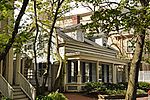Hiram Sands House
Cambridge, Massachusetts Registered Historic Place stubsHouses completed in 1848Houses on the National Register of Historic Places in Cambridge, Massachusetts

The Hiram Sands House is an historic house in Cambridge, Massachusetts. It is a 2+1⁄2-story brick structure, three bays wide, with a side-gable roof. Its gable ends are fully pedimented in the Greek Revival style, but the heavy brackets and modillions on the cornice are Italianate features, as are the window hoods and front porch. The house was built in 1848 by the second of three generations of Cambridge brickmakers, from clay dug nearby, and incorporates elements of both the Greek Revival and Italianate architectural styles. It was added to the National Register of Historic Places in 1976.
Excerpt from the Wikipedia article Hiram Sands House (License: CC BY-SA 3.0, Authors, Images).Hiram Sands House
Putnam Avenue, Cambridge Cambridgeport
Geographical coordinates (GPS) Address External links Nearby Places Show on map
Geographical coordinates (GPS)
| Latitude | Longitude |
|---|---|
| N 42.369416666667 ° | E -71.113194444444 ° |
Address
Putnam Avenue 22
02163 Cambridge, Cambridgeport
Massachusetts, United States
Open on Google Maps








